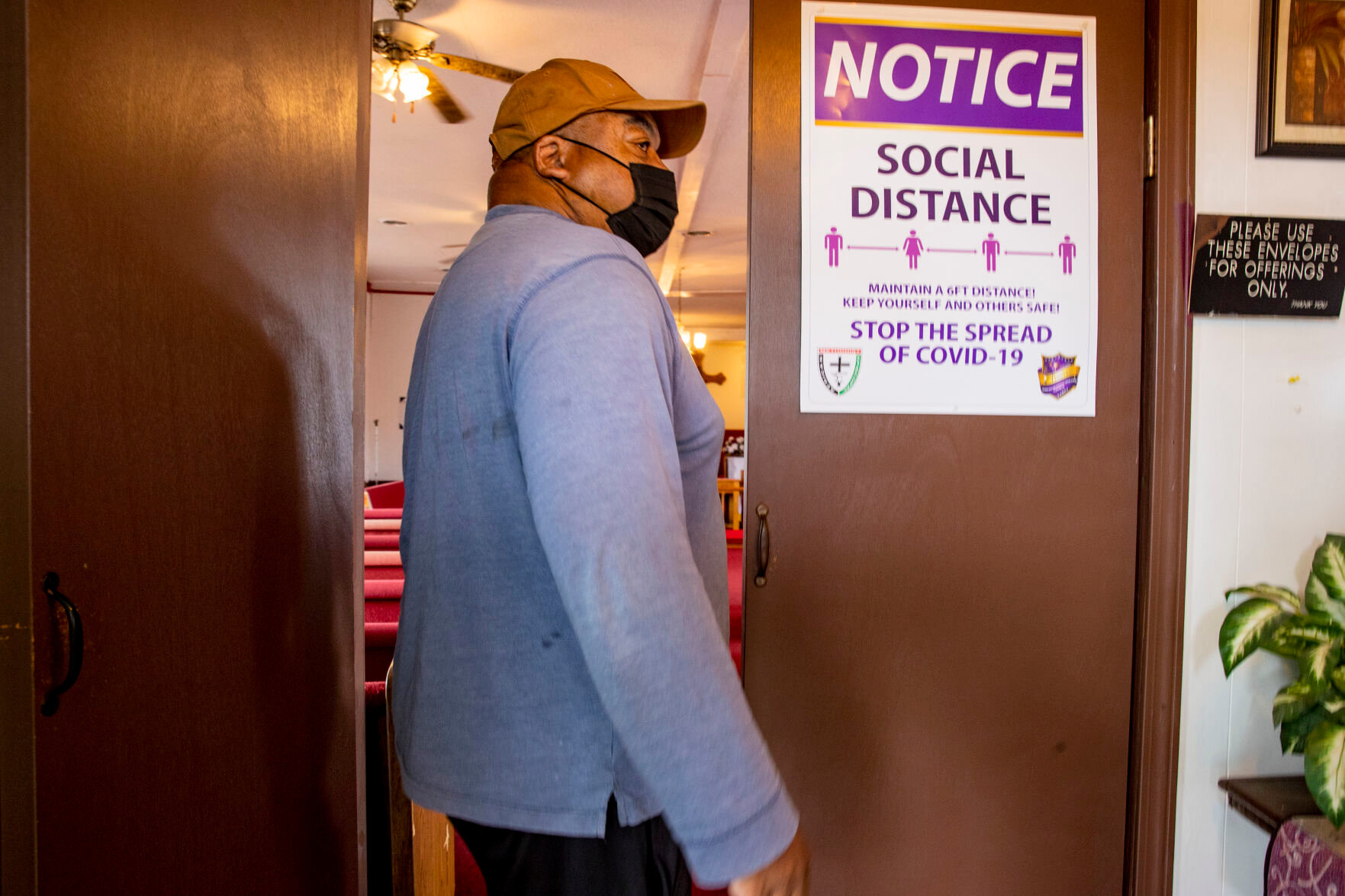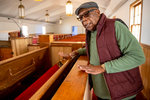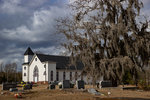Closing to dodge COVID-19, rural churches faced threat from another microbe: mold
Post and Courier
ALCOLU - Several months into the pandemic, the Rev. Franklin Colclough received a call from a member who'd seen something alarming at their church, Harmony Presbyterian.
Though the congregation was meeting virtually, she had come by to clean. A few members still gathered in-person to collect tithes, so Colclough asked her to focus there. He told her not to worry about the vacant sanctuary.
She peeked inside anyway and discovered a problem that many small rural churches faced after extended shutdowns: There was mildew and mold everywhere.
Colclough remembers walking through the sanctuary's back door and seeing fungus all the way to the front. The room was musty. Black spots had emerged on the walls and ceilings. Everything was cast in a dusty light green - the flags on the back wall, the Bibles and hymnals in the pews, the pews themselves. He ran his hand over the furniture, and a cloud of spores wafted up.
"I'd never seen anything like it, but we thank God for the fact it was more mildew than mold," Colclough said.
Cleaning the church, restoring furniture and repainting the walls ultimately cost the congregation more than $10,000, Colclough estimates. The damage at Harmony Presbyterian represents a hidden secondary toll of the pandemic on rural churches, an extra cost at a time when many are already struggling with declining membership and reduced collections. Unaddressed, mold poses a health risk to members with weakened immune systems or respiratory illnesses, and it can threaten the building's structure.
The scope of shutdown-related damage to churches has not been studied, but the extent of the problem emerges in government records in Clarendon County, which cut more than $1 million in checks to local nonprofits to help them through the pandemic.
Inside the dry language of government forms, the grant applications they received tell a story of problems that became widespread in this corner of the state: of mildew in fellowship halls and organ pipes, of ruined Bibles and collapsing structures.
Supporting churches
Clarendon County sits an hour and a half north of Charleston, cradled by Lake Marion and bisected by Interstate 95. But off the highway, the landscape is dotted with houses of worship.
"We've churches on top of churches. We've got so many churches," said Curt Richburg, a church-supply salesman who lives in Manning, the county seat.
So when county council decided in 2021 to set aside federal stimulus money to help local nonprofits, the program largely made grants to churches. Of the nearly $1.1 million distributed to nonprofits, records show that roughly $714,000 went to more than 75 religious groups.
Most of their requests addressed the sorts of COVID-19 expenses that have become commonplace after two years of pandemic: masks, cleaning supplies and ventilation upgrades. But as soon as the county began accepting applications, they heard from churches that were struggling with damage from moisture, said county finance chief Lynden Anthony, who ran the grant program.
All told, at least 17 churches reported mold and moisture issues, according to their applications, which The Post and Courier obtained through a Freedom of Information Act request.
They included churches that trace their history to the 1800s and two congregations that played key roles in the civil rights movement. One was Historic Mt. Zion AME Church, which held meetings on desegregation as one of its members sued the county board of education over its unequal treatment of Black and white students.
His case set the groundwork for Briggs vs. Elliott, the landmark desegregation case that the U.S. Supreme Court combined with Brown vs. Board. The families who filed the Briggs case met at another church nearby, Union Cypress AME. County records show mildew was found there, too, latching onto the walls and piano.
The grant applications also included funding requests that are striking in a country founded on ideals of keeping church and state separate. One congregation, for instance, asked for money to buy 50 hymnals and 72 King James Bibles, plus a cowhide-bound copy for the pulpit.
Clarendon County ultimately side-stepped those concerns when it determined that it wouldn't pay for mold remediation. The county took a strict reading of the U.S. Treasury Department's rules for stimulus funds, Anthony said. According to his interpretation, the money could be used to repair COVID-19-related damage to homes but not to public facilities.
Churches claiming moisture damage were asked to submit new applications, and the county divvied up money based on churches' sizes instead of their specific requests.
Whether churches ultimately used the grant funds to fix structural issues anyway is not altogether clear. The county did not require organizations to submit receipts showing how they spent the money, Anthony said. And the U.S. government has given counties and cities wide latitude to distribute stimulus money how they see fit. For instance, they can give grants to nonprofits and even private businesses as long as they can show the pandemic impacted their revenue.
And several churches with moisture problems draw a direct connection from the arrival of COVID-19 in South Carolina to the growth of mildew in their sanctuaries.
Rural issue
The churches that asked for help with mold are mostly small congregations, without the resources to keep the air on constantly, and most have had extended closures.
Clarendon County was one of the state's first coronavirus hotspots in 2020, with an early surge that disproportionately impacted elderly Black residents, who also make up most of the membership at the impacted churches. Church leaders say their congregations have been hesitant to return to in-person worship in light of the risks to older people.
Those dynamics may have created a unique set of circumstances. Leaders of several mainline Protestant denominations in South Carolina said they had not heard of mold issues among their congregations, perhaps because they hadn't been closed as long.
"While we've hit the pause button on worship a few times, we've never entirely shut down long enough to encounter mold and mildew problems," said the Rev. Jim Lewis, canon to the ordinary of the Anglican Diocese of South Carolina.
But as the months passed in Clarendon County, the problems grew more evident, local church leaders say.
At Historic Mount Zion AME, trustee chairman James Kindell noticed a few fine hairs of fungus grow darker and darker as he made visits to try to air out the sanctuary.
At Oak Grove Missionary Baptist, leaders decided to extend virtual services because moldy spots had grown on the walls, clerk George Frierson III said.
And at St. Peter AME, George McConico saw collections slip and challenges mount for his congregation, which has only about 15 active members. In the nearly century-old sanctuary, he saw the ceilings and pews gradually discolor, then turn yellowish-green. In the dining area, he saw the floor sink. When someone came to assess the damage, the man fell through to the ground.
St. Peter sits in the middle of a field - fallow, this time of year - at the end of a long driveway through a grove of trees. It's a few miles from Rimini, a crossroads community where the train stopped coming decades ago.
Its members regard St. Peter, founded in 1859, as the area's mother church. It has a deep history and broad roots; not long ago, the church received an offering from someone in Baltimore who still claimed the church as their own.
But like other rural churches, membership has fallen. Just two decades ago, there were enough members for Elijah McConico, a steward member, to start a youth choir with a dozen children. Now, the church's youngest member is out of school.
The dwindling membership has left St. Peter with few resources to fix its damage. George McConico, who chairs the church board, said the church has honored the county's instructions not to use grant money for repairs, and fixing the sunken floor drained the church's coffers.
He would like to replace the faded pew cushions, once covered in mildew, which members cleaned the best they could. He'd like to replace the ceiling fans' drooping blades, which had also been covered. At the start of February, they found a bathroom cabinet rotting, too.
"We don't have the funds for that right now," George McConico said.
He's eager to make the building safe and comfortable when members return, hopefully soon. The church went back to virtual services because of the omicron surge. The congregation is back to conference call services - back to missing out on reading and singing together, shaking hands and hugging, sharing Sunday morning with family and friends.
When the church would gather before COVID-19, each service was like building a fire, Elijah McConico said. Over a few hours, songs and devotionals set sparks, until the pastor's sermon ignited the room.
"Once you get the fire going, you get warm," he said.
The pandemic has made it harder to keep the flame going.
Rickey Ciapha Dennis Jr. contributed to this report from Charleston.
More Articles to Read












